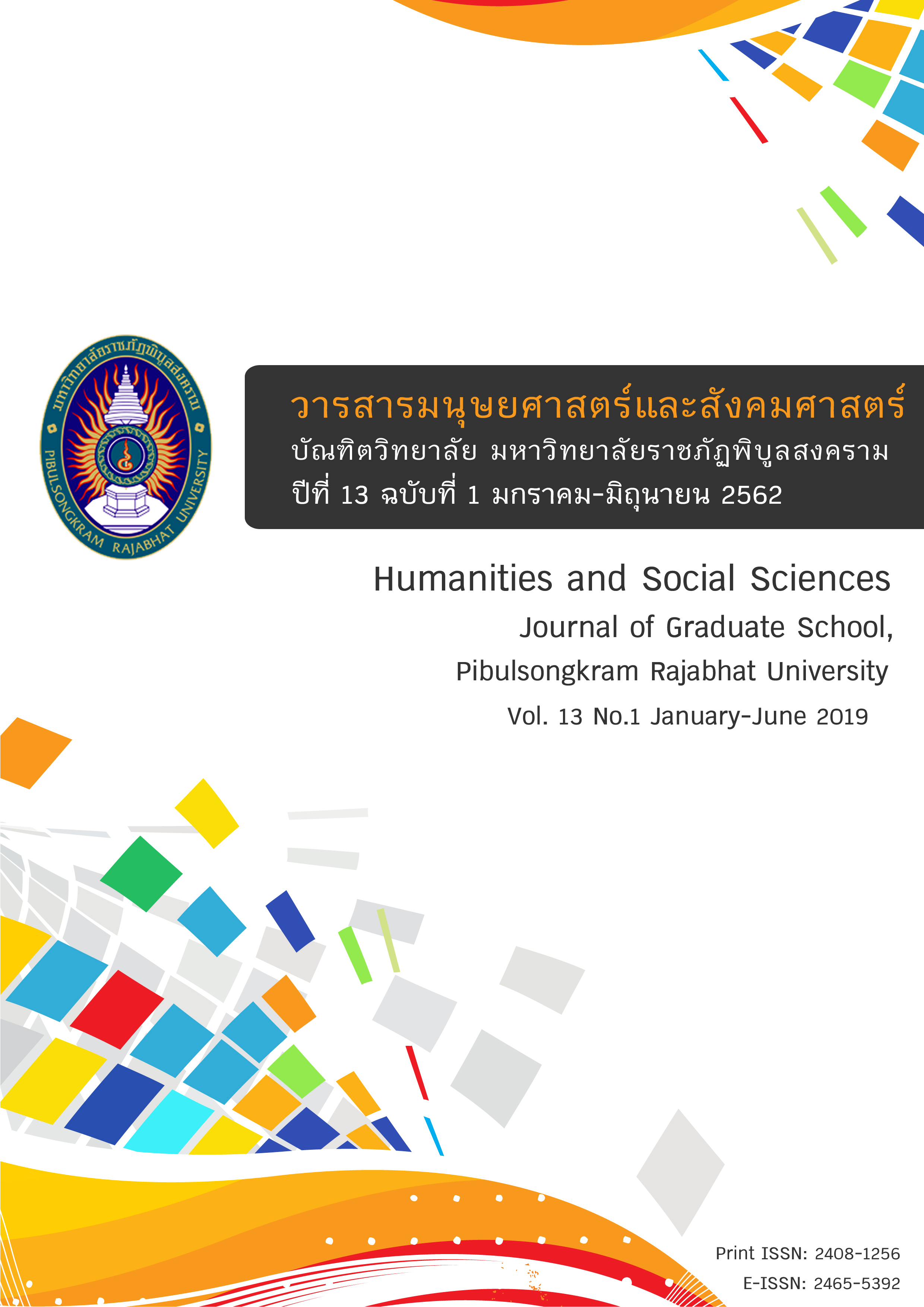A Development of Activity Curriculum on Imagery and Relaxation for Students Participating Performing Arts Competition
Keywords:
Curriculum development, The imagery and relaxation for performing, Students participating performing arts competitionAbstract
The purpose of this research was to develop the activity curriculum on imagery and relaxation for students participating performing arts competition. There were three procedures in this research and development process as follows: 1) Creating and checking the quality of the activity curriculum on imagery and relaxation checked by the expert for suitability and feasibility. 2) Try out the curriculum on imagery and relaxation for the students of Thai dance club, Sawang Daen Din School, Sawang Daen Din District, Sakon Nakhon Province, who were competing the Thai Dance competition at the Pong Land Exhibitiion in Kalasin during the second semester of the academic year 2015. There were 12 students purposively sampling taking 20 hours for experiment. 3) The evaluation of satisfaction for the activity curriculum on imagery and relaxation for students participating performing arts competition was conducted by using percentage, mean, standard deviation and different score.
The results of this research after using the curriculum were as follows: 1) The activity curriculum on imagery and relaxation for students participating performing arts competition consisted of 6 factors that were principle, purpose, material and structure, teaching and learning approach, measurement, and using instructional media. The curriculum was divided into 5 lessons: 1) the basic of performing on stage, 2) the principle of performing on stage, 3) the basic of imagery and relaxation, 4) the practice of imagery and relaxation methods, and 5) the performance on real situation. In addition, the quality of curriculum and curriculum document were checked and were the most appropriate, and the result of curriculum pilot study was practical. 2) The results of the experiment of this curriculum were as follows: 1) the students were able to perform their performing arts at a high level with the mean of 95.23 percent comparing with the criterion 80 percent; 2) the students were low-level stress, with the mean of 28.33 percent. 3) The students were satisfied with activity curriculum on imagery and relaxation for students participating performing arts competition at a highest level with the mean of ( = 4.87, S.D. = 0.13).
References
กรมวิชาการ กระทรวงศึกษาธิการ. (2552). หลักสูตรแกนกลางการศึกษาขั้นพื้นฐาน พุทธศักราช 2551. กรุงเทพฯ: ชุมนุมสหกรณ์การเกษตรแห่งประเทศไทย.
ใกล้รุ่ง คำภิลานน. (2558). การพัฒนาหลักสูตรเสริมสร้างความฉลาดทางสุขภาวะเกี่ยวกับโรคอ้วน สำหรับนักเรียนชั้นมัธยมศึกษาปีที่ 3 (วิทยานิพนธ์ปริญญาดุษฎีบัณฑิต). มหาวิทยาลัยนเรศวร, พิษณุโลก.
ไชยวัฒน์ ผลประดิษฐ์. (2556). การฝึกจินตภาพและการฝึกการพูดกับตนเองที่มีต่อความวิตกกังวลก่อน
การแข่งขันของนักกีฬารักบี้ฟุตบอล (วิทยานิพนธ์ปริญญามหาบัณฑิต). มหาวิทยาลัยศรีนครินทรวิโรฒประสานมิตร, กรุงเทพฯ.
ทองแท้ ศิลาขาว. (2536). ผลของการฝึกผ่อนคลายกล้ามเนื้อที่มีต่อความวิตกกังวลด้านการเรียนของนักเรียน
ชั้นมัธยมศึกษาปีที่ 6 จังหวัดปทุมธานี (วิทยานิพนธ์ปริญญามหาบัณฑิต). มหาวิทยาลัยศรีนครินทรวิโรฒประสานมิตร, กรุงเทพฯ.
นิติไทย นัมคณิสรณ์. (2537). การเปรียบเทียบผลของการฝึกผ่อนคลายกล้ามเนื้อและการใช้สถานการณ์จำลอง
ที่มีต่อความวิตกกังวลก่อนการแสดงของนักเรียนชั้นมัธยมศึกษาปีที่ 3 วิทยาลัยนาฏศิลปจันทบุรี จังหวัดจันทบุรี (วิทยานิพนธ์ปริญญามหาบัณฑิต). มหาวิทยาลัยศรีนครินทรวิโรฒประสานมิตร, กรุงเทพฯ.
นาฎสุรีย์ วงศ์อรินทร์. (2558). การพัฒนาหลักสูตรรายวิชาเพิ่มเติม ฟ้อนคนแพร่นี้ใจงาม สำหรับนักเรียนชั้นมัธยมศึกษาตอนต้น (การค้นคว้าอิสระปริญญามหาบัณฑิต). มหาวิทยาลัยนเรศวร, พิษณุโลก.
วิชฏาลัมพก์ เหล่าวานิช. (2556). การประเมินผลศิลปะดนตรีนาฏศิลป์แบบบรูณาการและตามสภาพการณ์จริง ผ่านกิจกรรมวัดประเมินผลการเรียนรู้กลุ่มสาระการเรียนรู้ศิลปะโรงเรียนสาธิตจุฬาลงกรณ์มหาวิทยาลัยฝ่ายมัธยม (วิทยานิพนธ์ปริญญามหาบัณฑิต). มหาวิทยาลัยมหิดล, นครปฐม.
สำลี รักสุทธี. (2544). เทคนิควิธีการเขียนหลักสูตร. กรุงเทพฯ: พัฒนาศึกษา.
Eun, H. J. (2012). The application of imagery to enhance “flow state” in dancers. Australia: School of Sport and Exercise Science, Faculty of Arts, Education and Human Development, Victoria University London.
Tyler, R. W. (1950). Basic Principles of curriculum and Instruction. Chicago: The University of Chicago Press.
Taba, H. (1962). Curriculum Development: throry and Practice. New York: Harcourt Brace and World.
Downloads
Published
How to Cite
Issue
Section
License
Any articles or comments appearing in the Journal of Humanities and Social Sciences, Rajabhat Phibulsongkram University, are the intellectual property of the authors, and do not necessarily reflect the views of the editorial board. Published articles are copyrighted by the Journal of Humanities and Social Sciences, Rajabhat Phibulsongkram University.









